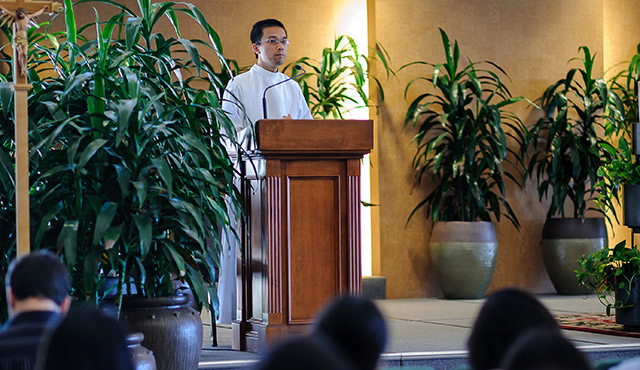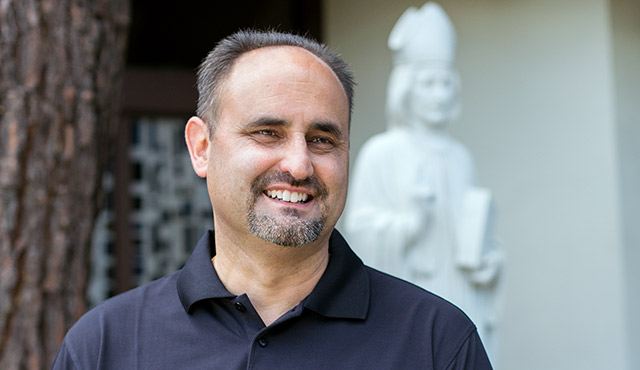For a young man born in Saigon and raised in Fountain Valley, God’s call to the priesthood took him halfway around the world to the heady, acutely Catholic Pontifical North American College Seminary in Rome, and back again.
For 10 months beginning last fall, Nicolaus Thai was interning at Santa Clara de Asis Church in Yorba Linda under the tutelage of Father Fred Bailey. Thai was able to assist in a variety of ways from “my participation in and giving reflections at Masses, attending Pastoral Council, staff and financial meetings, works of charity, sitting in pastor’s meetings and appointments, interacting with parishioners before and after Masses, and taking care of parish odds and ends.”
In July, at Santa Clara, Thai the seminarian became Deacon Nicolaus Thai. He was ordained to the transitional diaconate, which is the classification for a deacon who will take Holy Orders for the priesthood within a year. He is back in Rome now finishing his studies. Once ordained, his experiences in the Vatican and during his internship will be the foundation of his life as a priest in the Diocese of Orange.
David Otto had been a longtime parishioner at St. Bonaventure Church in Huntington Beach. Working at Vons to finance his way through college at California State University Long Beach, he had his life pretty planned out. He figured he would marry his girlfriend of six years and with his degree settle into his life and career. But then things changed.
“I always had a hint that God wanted me to be a priest, but it took me many years and experiences in life to gain the courage to follow this path,” recalls Otto. “I have always been a Catholic, but it took a real encounter with Christ for all of this to come together. Almost like a spark igniting my faith to burn brightly.”
Otto was 36 when he entered St. John’s Seminary in Camarillo. He recently completed his pastoral internship year at St. Anne Church in Santa Ana under the supervision of Pastor Father Antonio Lopez-Flores, and Parochial Vicars Fathers Joseph Nguyen and Ruben Ruiz. At St. Anne’s he not only worked within the parish, but also learned about the school and the role of the priest in Catholic elementary school education.
“I had to dig deep to bring out my Spanish since this was a predominately Hispanic community,” he says. “The most important thing I learned from my pastoral year was that my call to the priesthood grew stronger. It confirmed that I was on the right path.”
In June, Otto became Deacon Dave Otto, and has been assigned to serve at his home parish, St. Bonaventure, under the supervision of Father Joe Knerr. He recalls that the transition from a man in the pews to the co-celebrant on the altar was a strange experience. In one of his first homilies before his hometown community, he reflected on the story of Jesus returning to Nazareth only to be ridiculed by his former neighbors (MT 13:54-58). “I told the congregation ‘Please don’t descend on me like the people of Nazareth did to Jesus,”’ Otto says. “Fortunately they laughed and I’m still here.”
According to Father John Moneypenny, Director of Vocations for the Diocese of Orange, time spent working in the parish gives the seminarians a chance to experience what the life of a parish priest entails. Under the supervision of the pastor, the seminarian is involved in most activities of parish ministry. It helps them in their discernment so that they have a clear idea of what the life is like, and the experience is beneficial whether the seminarian is young or of a more advanced age. Interestingly, David Otto, who is now 45, is not the oldest seminarian in the diocese. Several men have chosen the priesthood in mid-life and are answering the call.
The diocese currently has a record group of 43 men at various stages of seminary formation. With so many new faces entering the priesthood, many more parishes may be playing host to the next generation of diocesan priests. If all goes well, there will be five or six ordinations next year. And for pastors who are working long hours to serve the faithful, these new recruits likely will represent a welcome and promising sign for the future.


